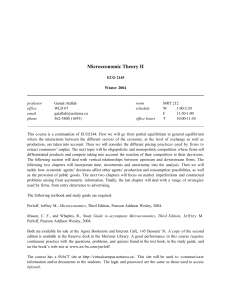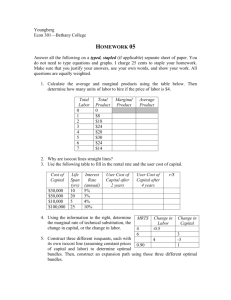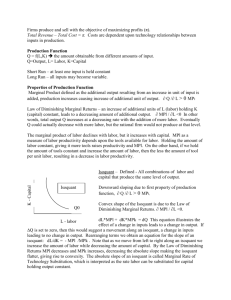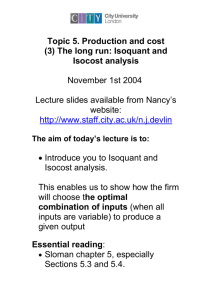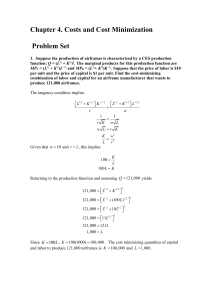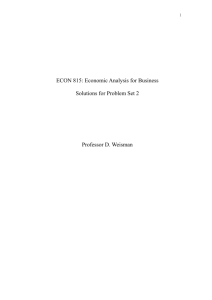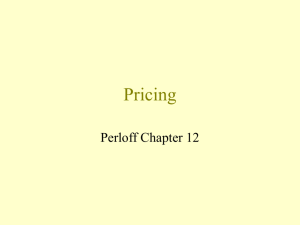Costs - personal.rdg.ac.uk
advertisement
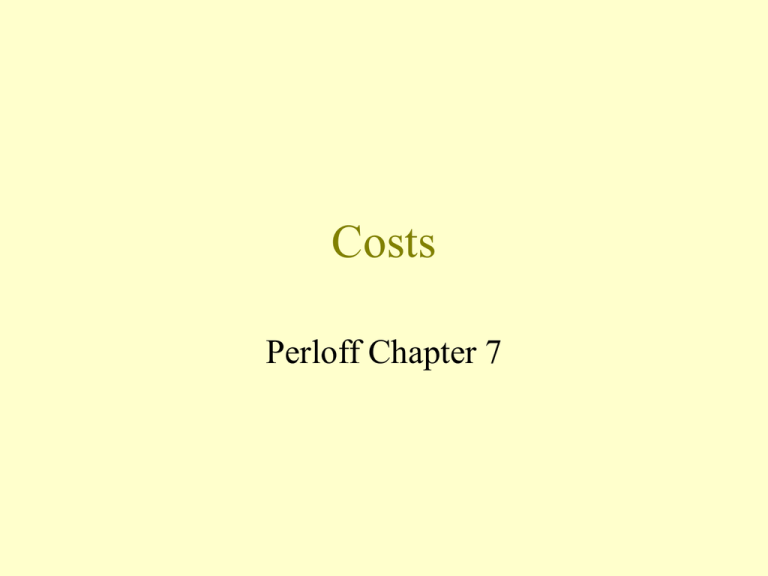
Costs Perloff Chapter 7 Economic cost • business (accounting) costs: only explicit costs (out of pocket) • economic costs: explicit cost + implicit cost = opportunity cost • opportunity cost – value of best alternative use of the resource – classic example: "There's no such thing as a free lunch" Short-run costs Source: Perloff Cost, $ 400 Short-run cost curves C VC 27 A 216 1 20 1 B 120 48 0 F 2 4 6 8 10 Quantity,q, Units per day 60 MC a 28 27 AVC b 20 AC 8 AFC 0 Source: Perloff 2 4 6 8 10 Quantity, q, Units per day Total product curve and VC Quantity, q, Units per day Total product of labor, Variable cost 13 10 6 5 1 0 Source: Perloff 5 25 20 24 100 120 46 230 77 385 L, Hours of labor per day VC = wL, Variable cost, $ Shape of MC and AC curve VC MC q MC w MC L q w MPL VC AC q wL q w AC APL AC The long-run: input choice C wL rK Source: Perloff C w K L r r Isocost Lines K, Units of capital per year C w K L r r $150 15 = ——— $10 $100 e 10 = ——— $10 d $50 5=— —— $10 c b $50 isocost $100 isocost $150 isocost a Source: Perloff $50 = — — — 10 $5 $100 $150 = ——— = 20 — —— 30 $5 $5 , Units of labor per year Cost minimisation K, Units of capital per year Lowest isocost rule Tangency rule q = 100 isoquant 3,000-kr isocost y 303 2,000-kr isocost 1,000-kr isocost x 100 z 28 0 Source: Perloff 24 50 116 L , Units of labor per year Three (equivalent) rules for cost minimisation 1. Lowest Isocost 2. Tangency w MPL MRTS r MPK 3. Last dollar rule (equimarginal returns) MPL MPK w r Cobb-Douglas example q 1.52 L0.6 K 0.4 q MPL 0.6 L q MPK 0.4 K At X: 100 1 .2 50 MPL 1.2 0.05 w 24 K, Units of capital per year x 100 MPL 0.6 100 0.4 100 MPK 0.4 0.05 w 8 MPK 0.4 Source: Perloff y 303 z 28 0 24 50 116 L, Units of labor per year At Y: 100 2 .5 24 MPL 2.5 0 .1 w 24 MPL 0.6 100 0.13 303 MPK 0.13 0.016 w 8 MPK 0.4 Factor price changes K, Units of capital per year q = 100 isoquant Original isocost, 2,000 kr New isocost, 1,032 kr 100 x v 52 0 Source: Perloff 50 77 L, Workers per year Expansion path K, Units of capital per year 4,000-kr isocost 3,000-kr isocost Expansion path 2,000-kr isocost z 200 y 150 x 100 0 Source: Perloff 200 isoquant 50 75 100 150 isoquant 100 isoquant L, Workers per year Long run total cost curve Long-run cost curve C, Cost, kroner 4,000 Z 3,000 2,000 0 Source: Perloff Y X 100 150 200 q, Units per year Returns to scale and LAC K, Units of capital per year d 8 q= 8 c d: Decreasing returns to scale c 4 q= 6 b 2 b c : Constant returns to scale a 1 Source: Perloff 0 q=3 q =1 1 2 4 a b: Increasing returns to scale 8 L, Work hours per year Returns to scale and LAC (cont) Source: Perloff K, Capital per year Long and short run expansion 4,616 kr Long-run expansion path 4,000 kr 2,000 kr z 200 y x 100 0 Source: Perloff 50 100 159 Short-run expansion path 200 isoquant 100 isoquant L, Workers per year Relationship between LAC and SAC Average cost, $ SRAC SRAC 1 b 12 10 a SRAC 3 3 LRAC SRAC 2 d c e 0 Source: Perloff q1 q2 q, Output per day Learning by doing Average cost Improvements in productivity which result from knowledge and experience Economies of scale A B Learning by doing C b AC 1 c AC 2 AC 3 q1 Source: Perloff q2 q3 q, Output per period
